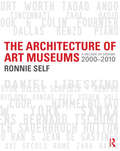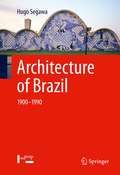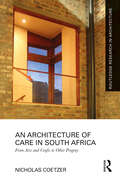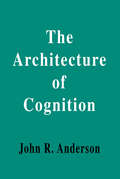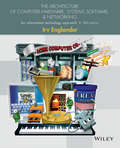- Table View
- List View
The Architecture of Art Museums: A Decade of Design: 2000 - 2010
by Ronnie SelfAs a building type, art museums are unparalleled for the opportunities they provide for architectural investigation and experimentation. They are frequently key components of urban revitalization and often push the limits of building technology. Art museums are places of pleasure, education and contemplation. They are remarkable by their prominence and sheer quantity, and their lessons are useful for all architects and for all building types. This book provides explicit and comprehensive coverage of the most important museums built in the first ten years of the 21st Century in the United States and Europe. By dissecting and analyzing each case, Ronnie Self allows the reader to get under the skin of each design and fully understand the process behind these remarkable buildings. Richly designed with full technical illustrations and sections the book includes the work of Tadao Ando, Zaha Hadid, Peter Cook & Colin Fournier, Renzo Piano, Yoshi Taniguchi, Herzog & de Meuron, Jean Nouvel, SANAA, Daniel Libeskind, Diller Scofidio & Renfro, Steven Holl, Coop Himmelb(l)au, Bernard Tschumi, Sauerbruch Hutton, and Shigeru Ban & Jean de Gastines. Together these diverse projects provide a catalogue of design solutions for the contemporary museum and a snapshot of current architectural thought and culture. One of few books on this subject written by an architect, Self’s analysis thoroughly and critically appraises each project from multiple aspects and crucially takes the reader from concept to building. This is an essential book for any professional engaged in designing a museum.
The Architecture of Art Museums: A Decade of Design: 2000 - 2010
by Ronnie SelfAs a building type, art museums are unparalleled for the opportunities they provide for architectural investigation and experimentation. They are frequently key components of urban revitalization and often push the limits of building technology. Art museums are places of pleasure, education and contemplation. They are remarkable by their prominence and sheer quantity, and their lessons are useful for all architects and for all building types. This book provides explicit and comprehensive coverage of the most important museums built in the first ten years of the 21st Century in the United States and Europe. By dissecting and analyzing each case, Ronnie Self allows the reader to get under the skin of each design and fully understand the process behind these remarkable buildings. Richly designed with full technical illustrations and sections the book includes the work of Tadao Ando, Zaha Hadid, Peter Cook & Colin Fournier, Renzo Piano, Yoshi Taniguchi, Herzog & de Meuron, Jean Nouvel, SANAA, Daniel Libeskind, Diller Scofidio & Renfro, Steven Holl, Coop Himmelb(l)au, Bernard Tschumi, Sauerbruch Hutton, and Shigeru Ban & Jean de Gastines. Together these diverse projects provide a catalogue of design solutions for the contemporary museum and a snapshot of current architectural thought and culture. One of few books on this subject written by an architect, Self’s analysis thoroughly and critically appraises each project from multiple aspects and crucially takes the reader from concept to building. This is an essential book for any professional engaged in designing a museum.
The Architecture of Blame and Praise: An Interdisciplinary Investigation
by David ShoemakerMany philosophers assume that to be a responsible agent is to be an apt target of responses like blame and praise. But what do these responses consist of, precisely? And do they really belong together, simply negative and positive symmetrical counterparts of each other? While there has been a lot of philosophical work on the nature of blame over the past 15 years--yielding multiple conflicting theories--there has been little on the nature of praise. Indeed, those few who have investigated praise--including both philosophers and psychologists--have concluded that it is quite different in some respects than blame, and that the two in fact may not be symmetrical counterparts at all. In this book, David Shoemaker offers the first detailed deep-dive into the complicated nature of blame and praise, teasing out their many varieties while defending a general symmetry between them. The book provides a thorough normative grounding for the many types and modes of blame and praise, albeit one that never appeals to desert or the metaphysics of free will. The volume draws from moral philosophy, moral psychology, the philosophy and psychology of humor, the psychology of personality disorders, and experimental economics. The many original contributions in the book include: the presentation and defense of a new functionalist theory of the entire interpersonal blame and praise system; the revelation of a heretofore unrecognized kind of blame; a discussion of how the capacities and impairments of narcissists tell an important story about the symmetrical structure of the blame/praise system; an investigation into the blame/praise emotions and their aptness conditions; an exploration into the key differences between other-blame and self-blame; and an argument drawn from economic games for why desert is unnecessary to render apt the ways in which blame sometimes sanctions.
The Architecture of Blame and Praise: An Interdisciplinary Investigation
by David ShoemakerMany philosophers assume that to be a responsible agent is to be an apt target of responses like blame and praise. But what do these responses consist of, precisely? And do they really belong together, simply negative and positive symmetrical counterparts of each other? While there has been a lot of philosophical work on the nature of blame over the past 15 years--yielding multiple conflicting theories--there has been little on the nature of praise. Indeed, those few who have investigated praise--including both philosophers and psychologists--have concluded that it is quite different in some respects than blame, and that the two in fact may not be symmetrical counterparts at all. In this book, David Shoemaker offers the first detailed deep-dive into the complicated nature of blame and praise, teasing out their many varieties while defending a general symmetry between them. The book provides a thorough normative grounding for the many types and modes of blame and praise, albeit one that never appeals to desert or the metaphysics of free will. The volume draws from moral philosophy, moral psychology, the philosophy and psychology of humor, the psychology of personality disorders, and experimental economics. The many original contributions in the book include: the presentation and defense of a new functionalist theory of the entire interpersonal blame and praise system; the revelation of a heretofore unrecognized kind of blame; a discussion of how the capacities and impairments of narcissists tell an important story about the symmetrical structure of the blame/praise system; an investigation into the blame/praise emotions and their aptness conditions; an exploration into the key differences between other-blame and self-blame; and an argument drawn from economic games for why desert is unnecessary to render apt the ways in which blame sometimes sanctions.
Architecture of Brazil: 1900-1990
by Hugo SegawaArchitecture of Brazil: 1900-1990 examines the processes that underpin modern Brazilian architecture under various influences and characterizes different understandings of modernity, evident in the chapter topics of this book. Accordingly, the author does not give overall preference to particular architects nor works, with the exception of a few specific works and architects, including Warchavchik, Niemeyer, Lucio Costa, and Vilanova Artigas.
An Architecture of Care in South Africa: From Arts and Crafts to Other Progeny (Routledge Research in Architecture)
by Nicholas CoetzerArchitects care. It is foundational and germane to the discipline and practice of architecture. This book charts the way the Arts and Crafts Movement established the moral ethos of ‘an architecture of care’ that not only remains embedded in current discourse and practice but also that is being given a more vocal presence in our climate-crisis and social justice world. By way of ‘genealogical strands’ the book charts the origin of ‘architecture of care’ ideas in the Arts and Crafts Movement and their impact on the ‘other progeny’ architectural projects in South Africa over the past hundred years. These range from the translation of inglenooks into an armature architecture of ‘Dignified Places’ in Cape Town’s townships to the ethos of ‘upliftment’ and care that translates from Octavia Hill through to ‘correcting’ building regulations and eventually finding a less moralising and more transformative impact in the ‘Hostels to Homes’ project. The birth of design through context and climate in the Arts and Crafts Movement is demonstrated by the shift in South African houses from boxy cottages to solar- and nature-oriented ribbon plans as demonstrated through the work of Helmut Stauch and Norman Eaton. The dislocation of Arts and Crafts ideas to the Cape also demonstrated a limit to the valorising of vernacular architecture and its ‘against-globalization’ building materials whereby English architects promoted Cape Dutch settler architecture and denigrated African vernacular architecture. As a final ‘genealogical strand,’ the book demonstrates the coherence of moral instrumentality with the animism and affects potential of handmade buildings. Written for academics, students and researchers interested in architectural history, it is an eye-opening investigation into the role of architecture in society.
An Architecture of Care in South Africa: From Arts and Crafts to Other Progeny (Routledge Research in Architecture)
by Nicholas CoetzerArchitects care. It is foundational and germane to the discipline and practice of architecture. This book charts the way the Arts and Crafts Movement established the moral ethos of ‘an architecture of care’ that not only remains embedded in current discourse and practice but also that is being given a more vocal presence in our climate-crisis and social justice world. By way of ‘genealogical strands’ the book charts the origin of ‘architecture of care’ ideas in the Arts and Crafts Movement and their impact on the ‘other progeny’ architectural projects in South Africa over the past hundred years. These range from the translation of inglenooks into an armature architecture of ‘Dignified Places’ in Cape Town’s townships to the ethos of ‘upliftment’ and care that translates from Octavia Hill through to ‘correcting’ building regulations and eventually finding a less moralising and more transformative impact in the ‘Hostels to Homes’ project. The birth of design through context and climate in the Arts and Crafts Movement is demonstrated by the shift in South African houses from boxy cottages to solar- and nature-oriented ribbon plans as demonstrated through the work of Helmut Stauch and Norman Eaton. The dislocation of Arts and Crafts ideas to the Cape also demonstrated a limit to the valorising of vernacular architecture and its ‘against-globalization’ building materials whereby English architects promoted Cape Dutch settler architecture and denigrated African vernacular architecture. As a final ‘genealogical strand,’ the book demonstrates the coherence of moral instrumentality with the animism and affects potential of handmade buildings. Written for academics, students and researchers interested in architectural history, it is an eye-opening investigation into the role of architecture in society.
The Architecture of Clouds
by Howard B. BluesteinThe Architecture of Clouds describes in a visual, poetic, and personal way how clouds are related to our everyday life and the weather. It expertly details how the art and science of clouds are interconnected with straightforward scientific explanations of the meteorological context in which clouds appear and why they form, alongside in-depth descriptions of the visual and artistic aspects of clouds. The air motion dynamics, cloud microphysics and thermodynamics discussed are written in a style accessible to all readers. The clouds showcased within the text range from placid ground fog to smoothly sculpted, stationary, mountain-wave clouds to violent clouds associated with convective storms, tornadoes, and hurricanes. Clouds are classified as whether they are buoyant or not, and if they are, how deep they extend through the atmosphere. An exhaustive and impressive compilation of photos taken from all over the world, including photographs taken from satellites, are featured in each chapter. Radar depictions of the inside of some clouds and storms provide a unique addition. This book provides an abundance of detail and photography that will be appreciated by scientists, students, and any reader interested in exploring beyond the aesthetics of clouds.
The Architecture of Cognition (Cognitive Science Ser. #No. 5)
by John R. AndersonNow available in paper, The Architecture of Cognition is a classic work that remains relevant to theory and research in cognitive science. The new version of Anderson's theory of cognitive architecture -- Adaptive Control of Thought (ACT*) -- is a theory of the basic principles of operation built into the cognitive system and is the main focus of the book.
The Architecture of Cognition
by John R. AndersonNow available in paper, The Architecture of Cognition is a classic work that remains relevant to theory and research in cognitive science. The new version of Anderson's theory of cognitive architecture -- Adaptive Control of Thought (ACT*) -- is a theory of the basic principles of operation built into the cognitive system and is the main focus of the book.
The Architecture of Collapse: The Global System in the 21st Century (Clarendon Lectures in Management Studies)
by Mauro F. GuillénWhy are there so many crises in the world? Is it true that the global system is today riskier and more dangerous than in past decades? Do we have any tools at our disposal to bring these problems under control, to reduce the global system's proneness to instability? These are the tantalizing questions addressed in this book. Using a variety of demographic, economic, financial, social, and political indicators, the book demonstrates that the global system has indeed become an 'architecture of collapse' subject to a variety of shocks. An analysis of the global financial crisis of 2008, the bilateral relationship between the U.S. and China, and the European sovereign debt crisis illustrates how the complexity and tight coupling of system components creates a situation of precarious stability and periodic disruption. This state of affairs can only be improved by enhancing the shock-absorbing components of the system, especially the capacity of states and governments to act, and by containing the shock-diffusing mechanisms. In particular, those related to phenomena such as trade imbalances, portfolio investment, cross-border banking, population ageing, and income and wealth inequality.
The Architecture of Collapse: The Global System in the 21st Century (Clarendon Lectures in Management Studies)
by Mauro F. GuillénWhy are there so many crises in the world? Is it true that the global system is today riskier and more dangerous than in past decades? Do we have any tools at our disposal to bring these problems under control, to reduce the global system's proneness to instability? These are the tantalizing questions addressed in this book. Using a variety of demographic, economic, financial, social, and political indicators, the book demonstrates that the global system has indeed become an 'architecture of collapse' subject to a variety of shocks. An analysis of the global financial crisis of 2008, the bilateral relationship between the U.S. and China, and the European sovereign debt crisis illustrates how the complexity and tight coupling of system components creates a situation of precarious stability and periodic disruption. This state of affairs can only be improved by enhancing the shock-absorbing components of the system, especially the capacity of states and governments to act, and by containing the shock-diffusing mechanisms. In particular, those related to phenomena such as trade imbalances, portfolio investment, cross-border banking, population ageing, and income and wealth inequality.
The Architecture of Computer Hardware, Systems Software, and Networking: An Information Technology Approach
by Irv EnglanderThe Architecture of Computer Hardware, System Software, and Networking: An Information Technology Approach, 5th Edition provides the right amount of technical detail needed to succeed in the field. This accessible introduction provides the basic principles of computer system architecture and organization in the context of the current technological landscape. The author provides chapters on the fundamentals of networking as it relates to computer systems as well as all kinds of business systems, from entrepreneurial to small business, networked, distributed, and more. This valuable book provides IT professionals with several real-world case studies that clearly show how the concepts are applied in the field.
Architecture of Computing Systems: 34th International Conference, ARCS 2021, Virtual Event, June 7–8, 2021, Proceedings (Lecture Notes in Computer Science #12800)
by Lars Bauer Thilo Pionteck Christian HochbergerThis book constitutes the proceedings of the 34th International Conference on Architecture of Computing Systems, ARCS 2021, held virtually in July 2021. The 12 full papers in this volume were carefully reviewed and selected from 24 submissions. 2 workshop papers (VEFRE) are also included. ARCS has always been a conference attracting leading-edge research outcomes in Computer Architecture and Operating Systems, including a wide spectrum of topics ranging from fully integrated, self-powered embedded systems up to high-performance computing systems. It also provides a platform covering newly emerging and cross-cutting topics, such as autonomous and ubiquitous systems, reconfigurable computing and acceleration, neural networks and artificial intelligence. The selected papers cover a variety of topics from the ARCS core domains, including heterogeneous computing, memory optimizations, and organic computing.
Architecture of Computing Systems: 36th International Conference, ARCS 2023, Athens, Greece, June 13–15, 2023, Proceedings (Lecture Notes in Computer Science #13949)
by Georgios Goumas Sven Tomforde Jürgen Brehm Stefan Wildermann Thilo PionteckThis book constitutes the proceedings of the 36th International Conference on Architecture of Computing Systems, ARCS 2023, which took place in Athens, Greece, in June 2023.The 18 full papers in this volume were carefully reviewed and selected from 35 submissions.ARCS provides a platform covering newly emerging and cross-cutting topics, such as autonomous and ubiquitous systems, reconfigurable computing and acceleration, neural networks and artificial intelligence. The selected papers cover a variety of topics from the ARCS core domains, including energy efficiency, applied machine learning, hardware and software system security, reliable and fault-tolerant systems and organic computing.Back to top
Architecture of Computing Systems: 37th International Conference, ARCS 2024, Potsdam, Germany, May 14–16, 2024, Proceedings (Lecture Notes in Computer Science #14842)
by Thilo Pionteck Dietmar Fey Stefan Lankes Benno Stabernack Mathias PacherThis book constitutes the proceedings of the 37th International Conference on Architecture of Computing Systems, ARCS 2024, held in Potsdam, Germany, in May 2024. The 23 papers presented in this volume were carefully reviewed and selected from 33 submissions. These papers have been categorized in the following sections: Progress in Neural Networks; Organic Computing; Computer Architecture Co-Design; Progress in HPC; Computer Architectures; and Dependability and Fault Tolerance.
Architecture of Computing Systems: 35th International Conference, ARCS 2022, Heilbronn, Germany, September 13–15, 2022, Proceedings (Lecture Notes in Computer Science #13642)
by Martin Schulz Carsten Trinitis Nikela Papadopoulou Thilo PionteckThis book constitutes the proceedings of the 35th International Conference on Architecture of Computing Systems, ARCS 2022, held virtually in July 2022. The 18 full papers in this volume were carefully reviewed and selected from 35 submissions. ARCS provides a platform covering newly emerging and cross-cutting topics, such as autonomous and ubiquitous systems, reconfigurable computing and acceleration, neural networks and artificial intelligence. The selected papers cover a variety of topics from the ARCS core domains, including energy efficiency, applied machine learning, hardware and software system security, reliable and fault-tolerant systems and organic computing.
Architecture of Computing Systems – ARCS 2015: 28th International Conference, Porto, Portugal, March 24-27, 2015, Proceedings (Lecture Notes in Computer Science #9017)
by Luís Miguel Pinho Wolfgang Karl Albert Cohen Uwe BrinkschulteThis book constitutes the proceedings of the 28th International Conference on Architecture of Computing Systems, ARCS 2015, held in Porto, Portugal, in March 2015.The 19 papers presented together with three invited papers were carefully reviewed and selected from 45 submissions. The papers are organized in six sessions covering the topics: hardware, design, applications, trust and privacy, real-time issues and a best papers session.
Architecture of Computing Systems – ARCS 2018: 31st International Conference, Braunschweig, Germany, April 9–12, 2018, Proceedings (Lecture Notes in Computer Science #10793)
by Mladen Berekovic Rainer Buchty Heiko Hamann Dirk Koch Thilo PionteckThis book constitutes the proceedings of the 31st International Conference on Architecture of Computing Systems, ARCS 2018, held in Braunschweig, Germany, in April 2018.The 23 full papers presented in this volume were carefully reviewed and selected from 53 submissions. ARCS has always been a conference attracting leading-edge research outcomes in Computer Architecture and Operating Systems, including a wide spectrum of topics ranging from embedded and real-time systems all the way to large-scale and parallel systems.
Architecture of Computing Systems – ARCS 2019: 32nd International Conference, Copenhagen, Denmark, May 20–23, 2019, Proceedings (Lecture Notes in Computer Science #11479)
by Martin Schoeberl Christian Hochberger Sascha Uhrig Jürgen Brehm Thilo PionteckThis book constitutes the proceedings of the 32nd International Conference on Architecture of Computing Systems, ARCS 2019, held in Copenhagen, Denmark, in May 2019. The 24 full papers presented in this volume were carefully reviewed and selected from 40 submissions. ARCS has always been a conference attracting leading-edge research outcomes in Computer Architecture and Operating Systems, including a wide spectrum of topics ranging from embedded and real-time systems all the way to large-scale and parallel systems. The selected papers are organized in the following topical sections: Dependable systems; real-time systems; special applications; architecture; memory hierarchy; FPGA; energy awareness; NoC/SoC. The chapter 'MEMPower: Data-Aware GPU Memory Power Model' is open access under a CC BY 4.0 license at link.springer.com.
Architecture of Computing Systems – ARCS 2020: 33rd International Conference, Aachen, Germany, May 25–28, 2020, Proceedings (Lecture Notes in Computer Science #12155)
by André Brinkmann Wolfgang Karl Stefan Lankes Sven Tomforde Thilo Pionteck Carsten TrinitisThis book constitutes the proceedings of the 33rd International Conference on Architecture of Computing Systems, ARCS 2020, held in Aachen, Germany, in May 2020.* The 12 full papers in this volume were carefully reviewed and selected from 33 submissions. 6 workshop papers are also included. ARCS has always been a conference attracting leading-edge research outcomes in Computer Architecture and Operating Systems, including a wide spectrum of topics ranging from embedded and real-time systems all the way to large-scale and parallel systems. The selected papers focus on concepts and tools for incorporating self-adaptation and self-organization mechanisms in high-performance computing systems. This includes upcoming approaches for runtime modifications at various abstraction levels, ranging from hardware changes to goal changes and their impact on architectures, technologies, and languages.*The conference was canceled due to the COVID-19 pandemic.
Architecture of Computing Systems - ARCS 2006: 19th International Conference, Frankfurt/Main, Germany, March 13-16, 2006, Proceedings (Lecture Notes in Computer Science #3894)
by Werner Grass Bernhard Sick Klaus WaldschmidtThis book constitutes the refereed proceedings of the 19th International Conference on Architecture of Computing Systems, ARCS 2006, held in March 2006. The 32 revised full papers presented together with two invited and keynote papers were carefully reviewed and selected from 174 submissions. The papers are organized in topical sections on pervasive computing, memory systems, architectures, multiprocessing, energy efficient design, power awareness, network protocols, security, and distributed networks.
Architecture of Computing Systems - ARCS 2007: 20th International Conference, Zurich, Switzerland, March 12-15, 2007, Proceedings (Lecture Notes in Computer Science #4415)
by Paul Lukowicz Lothar Thiele Gerhard TrösterThis book constitutes the refereed proceedings of the 20th International Conference on Architecture of Computing Systems, ARCS 2007, held in Zurich, Switzerland in March 2007. Coverage details a broad range of research topics related to basic technology, architecture, and application of computing systems with a strong focus on system aspects of pervasive computing and self organization techniques in both organic and autonomic computing.
Architecture of Computing Systems - ARCS 2008: 21st International Conference, Dresden, Germany, February 25-28, 2008, Proceedings (Lecture Notes in Computer Science #4934)
by Theo Ungerer Christian Hochberger Rainer G. SpallekThis book constitutes the refereed proceedings of the 21st International Conference on Architecture of Computing Systems, ARCS 2008, held in Dresden, Germany, in February 2008. The 19 revised full papers presented together with 2 keynote papers were carefully reviewed and selected from 47 submissions. The papers cover a wide spectrum reaching from pre-fabrication adaptation of architectural templates to dynamic run-time adaptation of deployed systems with special focus on adaptivity and adaptive system architectures. The papers are organized in topical sections on hardware design, pervasive computing, network processors and memory management, reconfigurable hardware, real-time architectures, organic computing, and computer architecture.
